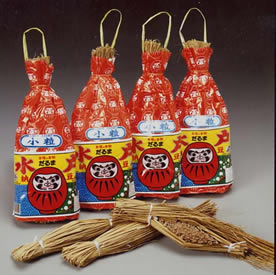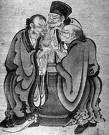::::::::::::::::::::::::::::::::::::::::::::::::::::::::::::::::::::::::::::::::::::::::::::::::::::
SUMMER KIGO : Preparing Food
Narazuke seisu 奈良漬製す (ならづけせいす)
making Narazuke pickles
Making Tsukemono Pickles
for priest Ikkyu 一休, see below.
::::::::::::::::::::::::::::::::::::::::::::::::::::::::::::::::::::::::::::::::::::::::::::::::::::
natto tsukuru 納豆造る (なっとうつくる)
late summer
Ikkyuu natto 一休納豆(いっきゅうなっとう)Ikkyu Natto
Daitokuji natto大徳寺納豆(だいとくじなっとう)
from temple Daitokuj-Ji
shiokara natto 塩辛納豆(しおからなっとう)with a lot of salt
kara natto 唐納豆(からなっとう)"Chinese-style natto"
tera natto 寺納豆(てらなっとう)natto made in a temple
Kyoo natto 京納豆(きょうなっとう)natto made in Kyoto
Takigi natto 薪納豆(たきぎなっとう)natto from Takigi
hama natto 浜納豆(はまなっとう) "beach natto", almost like miso paste
 This kigo refers to a special kind of natto prepared in summer, especially at the tempel Daitoku-Ji, in a way that Saint Ikkyu taught his disciples. It is prepared in summer and can be kept till winter, when it is eaten with a bit of Japanese mountain pepper powder.
This kigo refers to a special kind of natto prepared in summer, especially at the tempel Daitoku-Ji, in a way that Saint Ikkyu taught his disciples. It is prepared in summer and can be kept till winter, when it is eaten with a bit of Japanese mountain pepper powder.The Ikkyu Temple Shuon-an "Myosho-Ji Temple" (Myooshooji)
酬恩庵 / 一休寺
Takigi Satonouchi, Kyotanabe-shi
大徳寺精進料理・大徳寺納豆の大徳寺一久
http://www.daitokuji-ikkyu.jp/

Natto 納豆 ... Fermented Beans and Daruma san
History of regular Natto and more details.
:::::::::::::::::::::::::::::::::::::::::::::::::::::::::::::::::::::::::::::::::::::::::::::::::::::
Shooyu tsukuru 醤油作る (しょうゆつくる)
making soy sauce
hishio tsukuru 醤作る (ひしおつくる)
:::::::::::::::::::::::::::::::::::::::::::::::::::::::::::::::::::::::::::::::::::::::::::::::::::::
su tsukuru 酢作る すつくる making vinegar
late summer
Japanese vinegar is made from rice. One type of vinegar is made from fermented rice and another is made by adding rice vinegar to rice wine. Rice vinegar is quite sweet and mild. There are some local specialities.
Sanbaisu 三杯酢 ... "Vinegar with three flavors"
a mix of vinegar, soy sauce and sugar or sweetened rice wine (mirin)

The Three Vinegar Tasters in Asian Art
::::::::::::::::::::::::::::::::::::::::::::::::::::::::::::::::::::::::::::::::::::::::::::::::::::

Ikkyū (一休宗純, Ikkyū Sōjun, Ikkyu Sojun, 1394-1481)
was an eccentric, iconoclastic Japanese Zen Buddhist priest and poet. He had a great impact on the infusion of Japanese art and literature with Zen attitudes and ideals.
Ikkyū is one of the most significant (and eccentric) figures in Zen history. To Japanese children, he is a folk hero, mischievous and always out-smarting his teachers and the shogun. In addition to passed down oral stories, this is due to the very popular animated TV series "Ikkyū-san". In Rinzai Zen tradition, he is both heretic and saint. Ikkyū was among the few Zen priests who argued that his enlightenment was deepened by consorting with pavilion girls. He entered brothels wearing his black robes, since for him sexual intercourse was a religious rite. At the same time he warned Zen against its own bureaucratic politicising.
Usually he is referred to as one of the main influences on the Fuke sect of Rinzai zen, as he is one of the most famous flute player mendicants of the medieval times of Japan. The piece "Murasaki Reibo" is attributed to him.
© More in the WIKIPEDIA !

This book examines the Japanese culture of the Muromachi epoch (14-16 centuries) with Ikkyū Sōjun (1394-1481), a celebrated monk and poet, as its focal point. Ikkyū’s contribution to the culture of his time was all-embracing and unique. He can be called the embodiment of his era, given that all the features typical for the Japanese culture of the High Middle Ages were concentrated in his personality. This multidisciplinary study of Ikkyū’s artistic, religious, and philosophical heritage reconstructs his creative mentality and his way of life. The aesthetics and art of Ikkyū are shown against a broad historical background. Much emphasis is given to Ikkyū’s interpretation of Zen.
- source : www.dajf.org.uk/event
有ろじより 無ろじへ帰る 一休み
雨ふらば降れ 風ふかば吹け
on the way from the world of passion
to the world of enlightenment
I take a break !
if it rains, let it rain
if the wind blows, let it blow
His name, (Ikkyu 一休), means "taking a break".
This poem is where he took his name from.
- - - - -
Many paths lead
from the foot of the mountain,
But at the peak
We all gaze at the
Single bright moon.

- - - - -
a waka by Zen master Ikkyu 一休禅師
about living in the mountains, with three tan of paddies, some miso paste, a young attendant and fresh water - all you need to be content.
山居せば上田三反味噌八斗
小者一人に水の良き所
In his memory, a hokku about three tan of paddies by
. Matsuo Basho 松尾芭蕉 - Archives of the WKD .
一休が土器買む年の市
. Ikkyuu ga kawarake kawanu toshi no ichi .
another hokku for Ikkyu by Matsuo Basho !
大比叡やしの字を引いて一霞
. Oo-Hie ya shi no ji o hiite hito kasumi .
Here Basho is most probably referring to a story about priest Ikkyu.
In the collection of stories about Ikkyu (Ikkyuu banashi 一休咄) there is one where Ikkyu had encouraged the monks of the famous monastery at Mount Hieizan to imagine the letter SHI し to be written in one brave stroke from the top of the mountain down to the town of Sakamoto at its foot.
. Basho and Mount Hiei-zan 比叡山 .
.......................................................................
What is not a dream?
Who will not end up as a skeleton? We appear as skeletons covered with skin — male and female — and lust after each other. When the breath expires, though, the skin ruptures, sex disappears, and there is no more high or low. Underneath the skin of the person we fondle and caress right now is nothing more than a set of bare bones.
Think about it — high and low, young and old, male and female, all are the same.”
–Ikkyū (“Skeletons,” 1457) Translated by John Stevens
https://multoghost.wordpress.com/2015/05/17/ikkyu-and-the-hell-courtesan/
.......................................................................

Every day, priests
minutely examine the Law . .
And endlessly chant
complicated sutras.
Before doing that, though,
they should learn
how to read the love letters
sent by the wind and rain,
snow and moon ...
*****************************
Related words
***** Beans (mame マメ / 豆 )
WASHOKU ... Japanese Food SAIJIKI
:::::::::::::::::::::::::::::::::::::::::::::::::::::::::::::::::::::::::::::::::::::::::::::::::::::::::::::::::::::::::::
[ . BACK to DARUMA MUSEUM TOP . ]
[ . BACK to WORLDKIGO . TOP . ]
- #ikkyu -
:::::::::::::::::::::::::::::::::::::::::::::::::::::::::::::::::::::::::::::::::::::::::::::::::::::::::::::::::::::::::::




1 comment:
Ikkyu
正月は 冥土の旅の 一里塚
めでたくもありめでたくもなし
shoogatsu wa meido no tabi no ichirizuka
medetaku mo ari medetaku mo nashi
New Year is a milestone mound on my way
to the Nether World
maybe that is auspicious, maybe that is not auspicious . . .
Said to be a poem by Zen priest Ikkyu, traveling on a dangerous road.
. Ikkyū 一休宗純 Ikkyū Sōjun, Ikkyu Sojun . - (1394 - 1481)
.
https://edoflourishing.blogspot.com/2019/07/ichirizuka-milestone-mound.html
.
Post a Comment